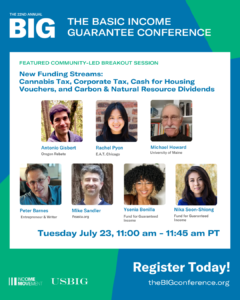
Carbon Dividends on the agenda at the BIG Conference
Carbon dividends (a.k.a Shares) will be on the agenda at the BIG Conference sponsored by the U.S. Basic Income Guarantee (USBIG) at the Fort Mason Center for Arts &

The principle behind Commons Share is that when a shared resource becomes limited, then the value that accrues from that scarcity should be returned to everyone, equally.
Commons Share can address major issues such as climate change and water scarcity in a way that also reduces economic inequality.
How It Works: A cap (limit) is placed on a resource, shares are allocated to each person on an equal basis, which may be traded among users so that conservation is rewarded, and the number of shares declines each year to meet the jurisdiction’s goals.



THE BASICS OF HOW IT WORKS
THE 5 STEPS OF COMMONS SHARE
When a commons is impacted by overuse or other constraints, a jurisdiction may impose a mandatory cap on overall use to manage the resource and meet conservation goals. A cap is a limit on what can be used (water) or what can be emitted (greenhouse gases) in a defined area in a certain time frame.
Setting a cap is a political decision that can be made at any size jurisdiction at the local, state, or federal level. The move toward a cap is often preceded by several years of local activism to educate policymakers about the need to reduce the emissions from or the use of a resource. With enough pressure, policymakers will acknowledge that in order to move forward with conservation goals, they need to set firm limits on usage. The cap provides a framework for a long-term goal, and is a mandatory, not voluntary, solution.
Typically, a cap includes a baseline year, baseline amount, and a target year. For example, the “Toronto target” for greenhouse gas emissions was a 20% reduction by 2020.
The cap is divided into allowances (also called permits or shares) representing resource use. Their scarcity gives them value, so it will become apparent if the cap is too loose or there are too many giveaways, loopholes, and exemptions. The next step is deciding how to allocate the allowances.
The allowances may be given for free to companies, utilities, or people, or they may be sold (auctioned) by the government, generating revenues, which may be used in a variety of ways, including consumer compensation and dividends.
TYPES OF SHARES FOR TYPES OF COMMONS

The Commons Share Project grew out of an initial goal to encourage a carbon market that supports the public trust in the implementation of California’s AB32 with Cap and Share, and Cap and Dividend. It has been expanded to include other types of Shares, including Fuel Share, Water Share, Mile Share, Diet Share, and the newest addition, Flight Share.

Carbon dividends (a.k.a Shares) will be on the agenda at the BIG Conference sponsored by the U.S. Basic Income Guarantee (USBIG) at the Fort Mason Center for Arts &